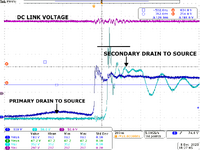sabu31
Advanced Member level 1
Hi all,
I am testing a phase shifted full bridge inverter. I am facing ringing on secondary side.
Without any snubber, I am seeing the Frequency as around 3.6Mhz and after adding a 10nF capacitor the frequency has reduced. But when I add a series resistor of 15 ohm along with it, there is a huge spike but after that the ringing dies of quickly. I am attaching the waveforms.

waveforms without using any snubber
Ch 2: Secondary side Device Drain to source voltage

Waveforms using 10nF across the drain to source
Ch 2: Secondary side Device Drain to source voltage
After adding a series resistor of 15Ohms, however, the peak again increases. What is the ideal value of resistance (typical range) that should be used for secondary of PSFB.
The device used is SQW61N65EF. What is the capacitance that should be considered for output parasitic capacitance? There are two values given in datasheet
Effective Output Capacitance, Time Related b= 841pF
Effective Output Capacitance, Energy Related a= 213pF
My original schematic is attached. Is there any reference/thumb rule for the calculation of secondary snubber. Also is both R-C snubber and RCD clamp both required in PSFB.
I am testing a phase shifted full bridge inverter. I am facing ringing on secondary side.
Without any snubber, I am seeing the Frequency as around 3.6Mhz and after adding a 10nF capacitor the frequency has reduced. But when I add a series resistor of 15 ohm along with it, there is a huge spike but after that the ringing dies of quickly. I am attaching the waveforms.
waveforms without using any snubber
Ch 2: Secondary side Device Drain to source voltage
Waveforms using 10nF across the drain to source
Ch 2: Secondary side Device Drain to source voltage
After adding a series resistor of 15Ohms, however, the peak again increases. What is the ideal value of resistance (typical range) that should be used for secondary of PSFB.
The device used is SQW61N65EF. What is the capacitance that should be considered for output parasitic capacitance? There are two values given in datasheet
Effective Output Capacitance, Time Related b= 841pF
Effective Output Capacitance, Energy Related a= 213pF
My original schematic is attached. Is there any reference/thumb rule for the calculation of secondary snubber. Also is both R-C snubber and RCD clamp both required in PSFB.
